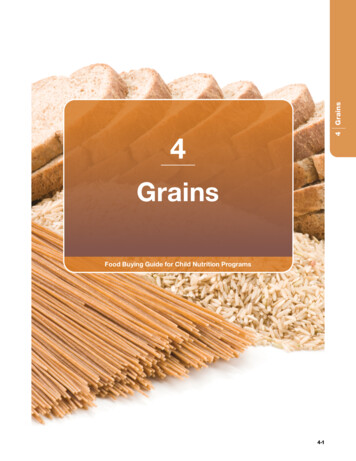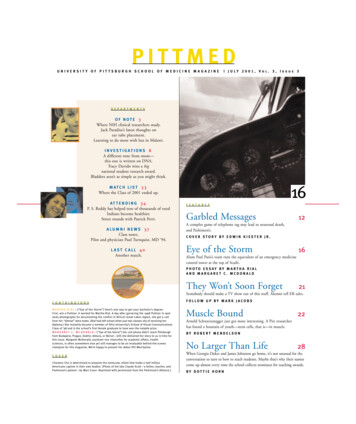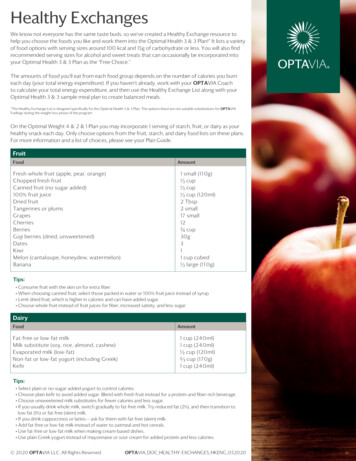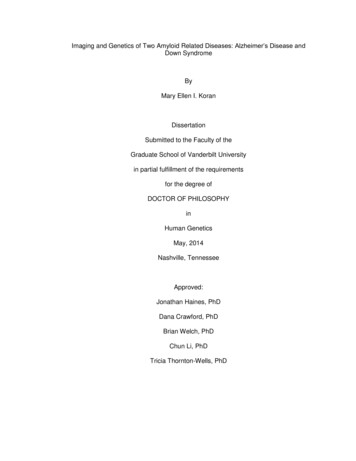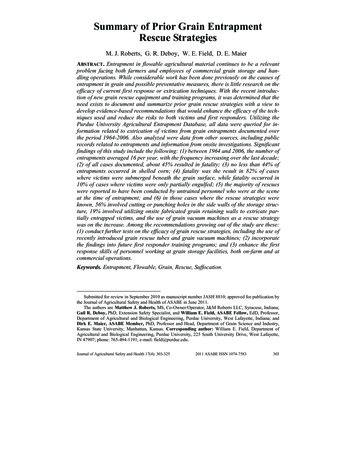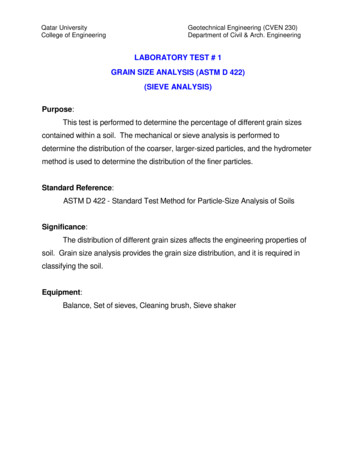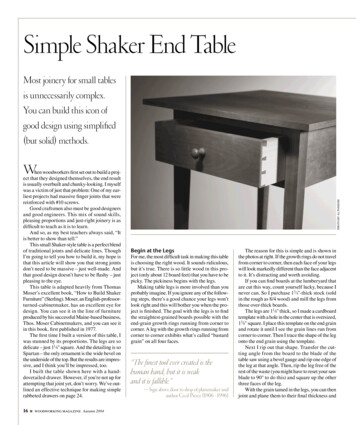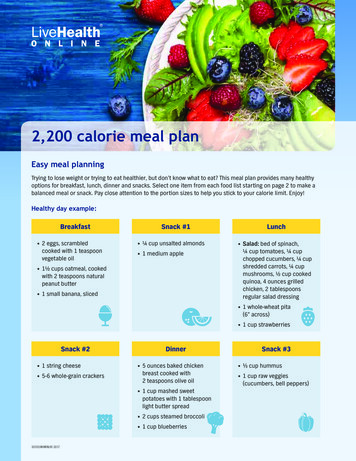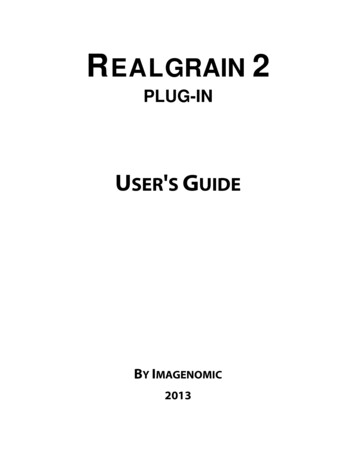
Transcription
25PROVEN STRATEGIESfor trading options on CME Group futures
A world of options ona single powerful platform.With more than 2.2 billion contracts (valued at 1.1 quadrillion) traded in 2007, CME Group is theworld’s largest and most diverse derivatives exchange.Building on the heritage of CME, CBOT and NYMEX,CME Group serves the risk management needs ofcustomers around the globe. As an internationalmarketplace, CME Group brings buyers and sellerstogether on the CME Globex electronic tradingplatform and on trading floors in Chicago and NewYork. CME Group offers the widest range of benchmarkproducts available across all major asset classes,including futures and options based on interest rates,equity indexes, foreign exchange, energy, agriculturalcommodities, metals, and alternative investmentproducts such as weather and real estate.Options on futures rank among our most versatilerisk management tools, and we offer them on mostof our products. Whether you trade options forpurposes of hedging or speculating, you can limit yourrisk to the amount you paid up-front for the optionwhile maintaining your exposure to beneficial pricemovements.CME Group is the trademark of CME Group, Inc. The Globe logo, Globex and CME aretrademarks of Chicago Mercantile Exchange, Inc. CBOT is the trademark of the Boardof Trade of the City of Chicago. NYMEX, New York Mercantile Exchange, and ClearPortare trademarks of New York Mercantile Exchange. Inc. COMEX is a trademark ofCommodity Exchange, Inc.Copyright 2008 CME Group. All rights reserved
HOW TO USE THIS BOOKLETPattern evolution:Each illustration demonstrates the effect of time decay on thetotal option premium involved in the position. The left verticalaxis shows the profit/loss scale. The horizontal zero line in themiddle is the break-even point, not including commissions.Therefore, anything above that line indicates profits, anythingbelow it, losses. The price of the underlying instrument isrepresented along the bottom. “A,” “B” and “C” in the diagramsindicate the strike prices. The arrows show the impact of timedecay on an option.Arrows on the diagram under the heading of “Pattern Evolution”indicate what impact the decay of option prices with time hason the total position. The purple line reflects the situation withfour months left until expiration, the gold line the status with onemonth left and the green line the situation at expiration.For more information,go to www.cmegroup.com/options.
Table of ContentsLong FuturesShort FuturesLong Synthetic FuturesShort Synthetic FuturesLong Risk Reversal(AKA Squash or Combos)Short Risk Reversal(AKA Squash or Combos)Long CallShort CallLong PutShort PutBull SpreadBear SpreadLong ButterflyShort ButterflyLong Iron ButterflyShort Iron ButterflyLong StraddleShort StraddleLong StrangleShort StrangleRatio Call SpreadRatio Put SpreadCall Ratio BackspreadPut Ratio BackspreadBox or 5
1LONG FUTURESAPattern evolution:When to use: When you are bullish on the market anduncertain about volatility. You will not be affected by volatilitychanging. However, if you have an opinion on volatility and thatopinion turns out to be correct, one of the other strategies mayhave greater profit potential and/or less risk.Profit characteristics: Profit increases as market rises. Profitis based strictly on the difference between the exit price and theentry price.Loss characteristics: Loss increases as market falls. Loss isbased strictly on the difference between the exit price and theentry price.Decay characteristics: None.CATEGORY: DirectionalSYNTHETICS: Long call A, short put A
SHORT FUTURESA2Pattern evolution:When to use: When you are bearish on the market anduncertain about volatility. You will not be affected by volatilitychanging. However, if you have an opinion on volatility and thatopinion turns out to be correct, one of the other strategies mayhave greater profit potential and/or less risk.Profit characteristics: Profit increases as market falls. Profit isbased strictly on the difference between the entry price and theexit price.Loss characteristics: Loss increases as market rises. Loss isbased strictly on the difference between the entry price and theexit price.Decay characteristics: None.CATEGORY: DirectionalSYNTHETICS: Long put A, short call A
3ALong SyntheticFuturesPattern evolution:When to use: When you are bullish on the market anduncertain about volatility. You will not be affected by volatilitychanging. However, if you have an opinion on volatility and thatopinion turns out to be correct, one of the other strategies mayhave greater profit potential and/or less risk. May be traded intofrom initial long call or short put position to create a strongerbullish position.Profit characteristics: Profit increases as market rises. Profitis based strictly on the difference between the exit price and thesynthetic entry price.Loss characteristics: Loss increases as market falls. Loss isbased strictly on the difference between the exit price and thesynthetic entry price.Decay characteristics: None.CATEGORY: DirectionalLong call A, short put A
Short SyntheticFuturesA4Pattern evolution:When to use: When you are bearish on the market anduncertain about volatility. You will not be affected by volatilitychanging. However, if you have an opinion on volatility and thatopinion turns out to be correct, one of the other strategies mayhave greater profit potential and/or less risk. May be traded intofrom initial short call or long put position to create a strongerbearish position.Profit characteristics: Profit increases as market falls. Profitis based strictly on the difference between the synthetic entry priceand the exit price.Loss characteristics: Loss increases as market rises. Loss isbased strictly on the difference between the synthetic entry priceand the exit price.Decay characteristics: None.CATEGORY: DirectionalLong put A, short call A
5A BLONG RISK REVERSAL(AKA SQUASHOR COMBOS)(SPLIT STRIKE)Pattern evolution:When to use: When you are bullish on the market anduncertain about volatility. Normally this position is initiated asa follow-up to another strategy. Its risk/reward is the same as aLONG FUTURES except that there is a flat area of little or nogain/loss.Profit characteristics: Profit increases as market rises abovethe long call strike price. Profit at expiration is open-ended andis based on the exercise price of B /– price received or paid toinitiate position.Loss characteristics: Loss increases as market falls belowthe short put. Loss at expiration is open-ended and is based onthe exercise price of A /– premium received or paid to initiateposition.Decay characteristics: Time decay characteristics varyaccording to the relationship of the call strike price, put strikeprice and the underlying futures price at the time the positionis established. The position is time decay neutral (not affected)if the futures price is exactly mid-way between the call and putstrike prices; long time decay (benefits from time decay) when thefutures price is closer to the call than the put strike price and shorttime decay (time decay erodes the value of the position) when thefutures price is closer to the put than the call strike price.CATEGORY: DirectionalLong call B, short put A
SHORT RISK REVERSAL(AKA SQUASHOR COMBOS)(SPLIT STRIKE)A B6Pattern evolution:When to use: When you are bearish on the market anduncertain about volatility. Normally this position is initiated asa follow-up to another strategy. Its risk/reward is the same as aSHORT FUTURES except that there is a flat area of little or nogain/loss.Profit characteristics: Profit increases as market falls belowthe long put strike price. Profit at expiration open-ended and isbased on the exercise price of A /– premium received or paid toinitiate position.Loss characteristics: Loss increases as market rises abovethe short call. Loss at expiration is open-ended and is based onthe exercise price of B /– premium received or paid to initiateposition.Decay characteristics: Time decay characteristics varyaccording to the relationship of the call strike price, put strikeprice and the underlying futures price at the time the positionis established. The position is time decay neutral (not affected)if the futures price is exactly mid-way between the call and putstrike prices; long time decay (benefits from time decay) when thefutures price is closer to the put than the call strike price and shorttime decay (time decay erodes the value of the position) when thefutures price is closer to the call than the put strike price.CATEGORY: DirectionalLong put A, short call B
7LONG CALLAPattern evolution:When to use: When you are bullish to very bullish on themarket. In general, the more out-of-the-money (higher strike)calls, the more bullish the strategy.Profit characteristics: Profit increases as market rises. Atexpiration, break-even point will be call option exercise price A price paid for call option.Loss characteristics: Loss limited to amount paid for option.Maximum loss realized if market ends below option exercise A.Decay characteristics: Position is a wasting asset. As timepasses, value of position erodes toward expiration value.CATEGORY: DirectionalSYNTHETICS: Long instrument, long put
SHORT CALLA8Pattern evolution:When to use: When you are bearish on the market. Sell outof-the-money (higher strike) puts if you are less confident themarket will fall: sell at-the-money puts if you are confident themarket will stagnate or fall.Profit characteristics: Profit limited to premium received.At expiration, break-even is exercise price A premium received.Maximum profit realized if market settles at or below A.Loss characteristics: Loss potential is open-ended. Lossincreases as market rises. At expiration, losses increase by onepoint for each point market is above break-even. Because risk isopen-ended, position must be watched closely.Decay characteristics: Position benefits from time decay.The option seller’s profit increases as option loses its time value.Maximum profit from time decay occurs if option is at-the-money.CATEGORY: DirectionalSYNTHETICS: Short instrument, short put
9LONG PUTAPattern evolution:When to use: When you are bearish to very bearish on themarket. In general, the more out-of-the-money (lower strike) theput option strike price, the more bearish the strategy.Profit characteristics: Profit increases as markets falls. Atexpiration, break-even point will be option exercise price A –price paid for option. For each point below break-even, profitincreases by additional point.Loss characteristics: Loss limited to amount paid for option.Maximum loss realized if market ends above option exercise A.Decay characteristics: Position is a wasting asset. As timepasses, value of position erodes toward expiration value.CATEGORY: DirectionalSYNTHETICS: Short instrument, long call
SHORT PUTA10Pattern evolution:When to use: If you firmly believe the market is not goingdown. Sell out-of-the-money (lower strike) options if you are onlysomewhat convinced: sell at-the-money options if you are veryconfident the market will stagnate or rise. If you doubt marketwill stagnate and are more bullish, sell in-the-money options formaximum profit.Profit characteristics: Profit limited to premium receivedfrom put option sale. At expiration, break-even point is exerciseprice A – premium received. Maximum profit realized if marketsettles at or above A.Loss characteristics: Loss potential is open-ended. Lossincreases as market falls. At expiration, losses increase by onepoint for each point market is below breakeven. Because risk isopen-ended, position must be watched closely.Decay characteristics: Position benefits from time decay.The option seller’s profit increases as option loses its time value.Maximum profit from time decay occurs if option is at-the-money.CATEGORY: DirectionalSYNTHETICS: Long instrument, short call
11BBULL SPREADAPattern evolution:When to use: If you think the market will go up, but withlimited upside. Good position if you want to be in the marketbut are less confident of bullish expectations. You’re in goodcompany. This is the most popular bullish trade.Profit characteristics: Profit limited, reaching maximum ifmarket ends at or above strike price B at expiration. If call-vs.call version (most common) used, break-even is at A net costof spread. If put-vs.-put version used, break-even is at B – netpremium collected.Loss characteristics: What is gained by limiting profitpotential is mainly a limit to loss if you guessed wrong onmarket. Maximum loss if market at expiration is at or below A.With call-vs.-call version, maximum loss is net cost of spread.Decay characteristics: If market is midway between A andB, little if any time decay effect. If market is closer to B, timedecay is generally a benefit. If market is closer to A, time decay isgenerally detrimental to profitability.CATEGORY: DirectionalLong call A, short call BLong put A, short put B
BEAR SPREADAB12Pattern evolution:When to use: If you think the market will go down, butwith limited downside. Good position if you want to be in themarket but are less confident of bearish expectations. The mostpopular position among bears because it may be entered as aconservative trade when uncertain about bearish stance.Profit characteristics: Profit limited, reaching maximumat expiration if market is at or below strike price A. If put-vs.-putversion (most common) used, break-even is at B – net cost ofspread. If call-vs.-call version, break-even is at A net premiumcollected.Loss characteristics: By accepting a limit on profits, youalso achieve a limit on losses. Losses, at expiration, increase asmarket rises to B, where they are at a maximum. With put-vs.put version, maximum loss is net cost of spread.Decay characteristics: If market is midway between A andB, little if any time decay effect. If market is closer to A, timedecay is generally a benefit. If market is closer to B, time decay isgenerally detrimental to profitability.CATEGORY: DirectionalShort put A, long put BShort call A, long call B
13BACLONGBUTTERFLYPattern evolution:When to use: One of the few positions which may be enteredadvantageously in a long-term options series. Enter when, withone month or more to go, cost of the spread is 10 percent or lessof B – A (20 percent if a strike exists between A and B). This is arule of thumb; check theoretical values.Profit characteristics: Maximum profit occurs if a market isat B at expiration. That profit would be B – A – net cost of spread.This profit develops, almost totally, in the last month.Loss characteristics: Maximum loss, in either direction, iscost of spread. A very conservative trade, break-evens are at A cost of spread and at C – cost of spread.Decay characteristics: Decay negligible until final month,during which distinctive pattern of butterfly forms. Maximumprofit growth is at B. If you are away from (A-C) range enteringthe last month, you may wish to liquidate position.CATEGORY: PrecisionLong call A, short 2 calls B, long call CLong put A, short 2 puts B, long put C(Note: B – A generally is equal to C – B)
shortButterflyACB14Pattern evolution:When to use: When the market is either below A or aboveC and position is overpriced with a month or so left. Or whenonly a few weeks are left, market is near B, and you expect animminent move in either direction.Profit characteristics: Maximum profit equals the credit atwhich spread is established. Occurs when market, at expiration,is below A or above C, thus making all options in-the-money or alloptions out-of-the-money.Loss characteristics: Maximum loss occurs if market is at Bat expiration. Amount of that loss is B – A – credit received whensetting up position. Break-evens are at A initial credit and C –initial credit.Decay characteristics: Decay negligible until final month,during which distinctive pattern of butterfly forms. Maximum lossacceleration is at B.CATEGORY: PrecisionShort call A, long 2 calls B, short call CShort put A, long 2 puts B, short put C(Note: B – A generally is equal to C – B)
15BACLONG IRONBUTTERFLYPattern evolution:When to use: One of the few positions which may be enteredadvantageously in a long-term options series. Enter when, withone month or more to go, cost of the spread is 10 percent or lessof B – A (20 percent if a strike exists between A and B). This is arule of thumb; check theoretical values.Profit characteristics: Maximum profit occurs if a marketis at B at expiration. Profit would be equal to short straddlepremium minus long strangle premium. This profit develops,almost totally, in the last month.Loss characteristics: Maximum loss, in either direction,net premium collected minus (B-A). This is a very conservativetrade, break-evens are at B and – net premium collected.Decay characteristics: Decay negligible until final month,during which distinctive pattern of butterfly forms. Maximumprofit growth is at B. If you are away from (A-C) range enteringthe last month, you may wish to liquidate position.CATEGORY: PrecisionShort 1 call and 1 put at B, buy 1 put at A, buy 1 call at Cor sell straddle at strike price A and buy strangle at ACfor protection(Note: B – A generally is equal to C – B)
Short IronButterflyACB16Pattern evolution:When to use: When the market is either below A or aboveC and position is overpriced with a month or so left. Or whenonly a few weeks are left, market is near B, and you expect animminent breakout move in either direction.Profit characteristics: Maximum profit equals (B – A) lessthe net debit to create the position. Occurs when market, atexpiration, is below A or above C.Loss characteristics: Maximum loss occurs if market is atB at expiration. Amount of that loss is net debit to create theposition. Break-evens are at B and – initial debit.Decay characteristics: Decay negligible until final month,during which distinctive pattern of butterfly forms. Maximumprofit growth is at B. If you are away from (A-C) range enteringlast month, you may wish to liquidate position.CATEGORY: PrecisionLong straddle B, short strangle at ACShort put A, long put B, long call B, short call C(Note: B – A generally is equal to C – B)
17LONGSTRADDLEAPattern evolution:When to use: If market is near A and you expect it to startmoving but are not sure which way. Especially good position ifmarket has been quiet, then starts to zigzag sharply, signalingpotential eruption.Profit characteristics: Profit open-ended in either direction.At expiration, break-even is at A, /– cost of spread. However,position is seldom held to expiration because of increasing timedecay with passage of time.Loss characteristics: Loss limited to the cost of spread.Maximum loss occurs if market is at A at expiration.Decay characteristics: Time decay accelerates as optionsapproach expiration. Position is generally liquidated well beforeexpiration.CATEGORY: PrecisionLong call A, long put ASYNTHETICS: Long 2 calls A, short instrumentLong 2 puts A, long instrument(All done to initial delta neutrality. A delta neutral spreadis a spread established as a neutral position by usingthe deltas of the options involved. The neutral ratio isdetermined by dividing the delta of the purchased optionby the delta of the written option)
SHORTSTRADDLEA18Pattern evolution:When to use: If market is near A and you expect market isstagnating. Because you are short options, you reap profits as theydecay – as long as market remains near A.Profit characteristics: Profit maximized if market, atexpiration, is at A. In call-put scenario (most common),maximum profit is equal to the credit from establishing position;break-even is A /– total credit.Loss characteristics: Loss potential open-ended in eitherdirection. Position, therefore, must be closely monitored andreadjusted to delta neutral if market begins to drift away from A.Decay characteristics: Because you are only short options,you pick up time-value decay at an increasing rate as expirationapproaches. Time decay is maximized if market is near A.CATEGORY: PrecisionShort call A, short put ASYNTHETICS: Short 2 calls A, long instrumentShort 2 puts A, short instrument(All done to initial delta neutrality)
19LONGSTRANGLEABPattern evolution:When to use: If market is within or near (A-B) range and hasbeen stagnant. If market explodes either way, you make money;if market continues to stagnate, you lose less than with a longstraddle. Also useful if implied volatility is expected to increase.Profit characteristics: Profit open-ended in either direction.Break-even levels are at A – cost of spread and B cost of spread.However, spread is usually not held to expiration.Loss characteristics: Loss limited. Loss is equal to net costof position. Maximum loss occurs if, at expiration, market isbetween A and B.Decay characteristics: Decay accelerates as options approachexpiration but not as rapidly as with long straddle. To avoidlargest part of decay, the position is normally liquidated prior toexpiration.CATEGORY: PrecisionLong put A, long call B(Generally done to initial delta neutrality)
SHORTSTRANGLEAB20Pattern evolution:When to use: If market is within or near (A-B) range and,though active, is quieting down. If market goes into stagnation,you make money; if it continues to be active, you have a bit lessrisk then with a short straddle.Profit characteristics: Maximum profit equals optionpremium collected. Maximum profit realized if market, atexpiration, is between A and B.Loss characteristics: At expiration, losses occur only ifmarket is above B option premium collected (for put-call) orbelow A – that amount. Potential loss is open-ended. Althoughless risky than short straddle, position is risky.Decay characteristics: Because you are short options, timevalue decays at an increasing rate as the option expiration dateapproaches; maximized if market is within A-B range.CATEGORY: PrecisionShort put A, short call B(All done to initial delta neutrality)
21BARATIO CALLSPREADPattern evolution:When to use: Usually entered when market is near A and userexpects a slight to moderate rise in market but sees a potentialfor sell-off. One of the most common option spreads, seldomdone more than 1:3 (two excess shorts) because of upside risk.Profit characteristics: Maximum profit, is equal to B – A –net cost of position (for call-vs.-call version), realized if market isat B at expiration or B – A net credit of position (if long optionpremium is less than premium collected from the sale of two ormore options).Loss characteristics: Loss limited on downside (to net costof position in call-vs.-call, or no loss if position established at acredit) but open-ended if market rises. Rate of loss, if marketrises beyond strike price B, is proportional to number of excessshorts in position.Decay characteristics: Depends on the net time valuepurchased or sold via this strategy. If more time value sold thanbought, then time value decays works to the benefit of theholder of this strategy.CATEGORY: PrecisionLong call A, short calls BFor example long 1 call @ A; short 2 calls @ B
RATIO PUTSPREADAB22Pattern evolution:When to use: Usually entered when market is near B and youexpect market to fall slightly to moderately, but see a potentialfor sharp rise. One of the most common option spreads, seldomdone more than 1:3 (two excess shorts) because of downside risk.Profit characteristics: Maximum profit in amount of B – A –net cost of position (for put-vs.-put version), realized if marketis at A at expiration, or B – A net credit of position (if longoption premium is less than premium collected from the sale oftwo or more options).Loss characteristics: Loss limited on upside (to net cost ofposition in put-vs.-put version, or no loss if position establishedat a credit) but open-ended if market falls. Rate of loss, if marketfalls below strike price A, is proportional to number of excessshorts in position.Decay characteristics: Dependent on the net time valuepurchased or sold via this strategy. If more time value sold thanbought, then time value decays works to the benefit of the holder.CATEGORY: PrecisionLong put B, short puts AFor example long 1 put @ B; short 2 puts @ A
23CALL RATIOBACKSPREADABPattern evolution:When to use: Normally entered when market is near B andshows signs of increasing activity, with greater probability toupside.Profit characteristics: Profit limited on downside (if netcredit taken in when position was established) but open ended inrallying market.Loss characteristics: Maximum loss, is amount of B – A –initial credit (or B – A initial debit), is realized if market is atB at expiration. This loss is less than for equivalent long straddle,the trade-off for sacrificing profit potential on the downside.Decay characteristics: Dependent on the net time valuepurchased or sold via this strategy. If more time value sold thanbought, then time value decays works to the benefit of the holder.CATEGORY: PrecisionShort call A, long 2 or more calls B
PUT RATIOBACKSPREADBA24Pattern evolution:When to use: Normally entered when market is near A andshows signs of increasing activity, with greater probability todownside (for example, if last major move was up, followed bystagnation).Profit characteristics: Profit limited on upside (to net credittaken in when position was established) but open ended incollapsing market.Loss characteristics: Maximum loss, is amount of B – A –initial credit (or B – A initial debit), realized if market is at A atexpiration. This loss is less than for the equivalent long straddle,the trade-off for sacrificing profit potential on the upside.Decay characteristics: Dependent on the net time valuepurchased or sold via this strategy. If more time value sold thanbought, then time value decays works to the benefit of the holder.CATEGORY: PrecisionShort 1 put B, long 2 or more puts A
25ABBOX ORCONVERSIONPattern evolution:When to use: Occasionally, a market will get out of line enoughto justify an initial entry into one of these positions. However,they are most commonly used to “lock” all or part of a portfolio bybuying or selling to create the missing “legs” of the position. Theseare alternatives to closing out positions at possibly unfavorableprices.Long box: Long a bull spread, long a bear spread — that is, longcall A, short call B, long put B, short put A. Value B – A – NetDebit.Short box: Long call B, short call A, long put A, short put B.Value Net Credit (A – B).Long-instrument conversion: Long instrument, long put A,short call A. Value 0. “Price” instrument put – A – call.Short-instrument conversion: Short instrument, long callA, short put A. Value 0. “Price” A call – instrument – put.CATEGORY: Locked or arbitrage trade.These spreads are referred to as “locked trades”because their value at expiration is totally independentof the price of the underlying instrument. If you can buythem for less than that value or sell them for more, youwill make a profit (ignoring commission costs).
For more information,go to www.cmegroup.com/options.Trading futures and options on futures is not suitable for all investors, and involves risk ofloss. Futures are a leveraged instrument, and because only a percentage of a contract'svalue is required to trade, it is possible to lose more than the amount of money initiallydeposited for a futures product.The information presented here has been compiled by CME Group for generalpurposes only. Although every attempt has been made to ensure the accuracy of theinformation within this brochure, CME Group assumes no responsibility for any errorsor omissions. Additionally, all examples in this brochure are hypothetical situations,used for explanation purposes only, and should not be considered investmentadvice or the results of actual market experience. All matters pertaining to rules andspecifications herein are made subject to and superseded by official CME, CBOTNYMEX, COMEX and CME Group rules. Current rules should be consulted in all casesconcerning contract specifications.
CME GROUP HEADQUARTERSCME GROUP GLOBAL OFFICES20 South Wacker DriveChicago, Illinois 60606cmegroup.comChicagoHong KongNew YorkLondonHoustonSingaporeWashington D.C.Sydneyinfo@cmegroup.com312 930 1000TokyoCME113/2M/0908
put option strike price, the more bearish the strategy. Profit characteristics: Profit increases as markets falls. At expiration, break-even point will be option exercise price A – price paid for option. For each point below break-even, profit increases by additional point. loss characteristics:
